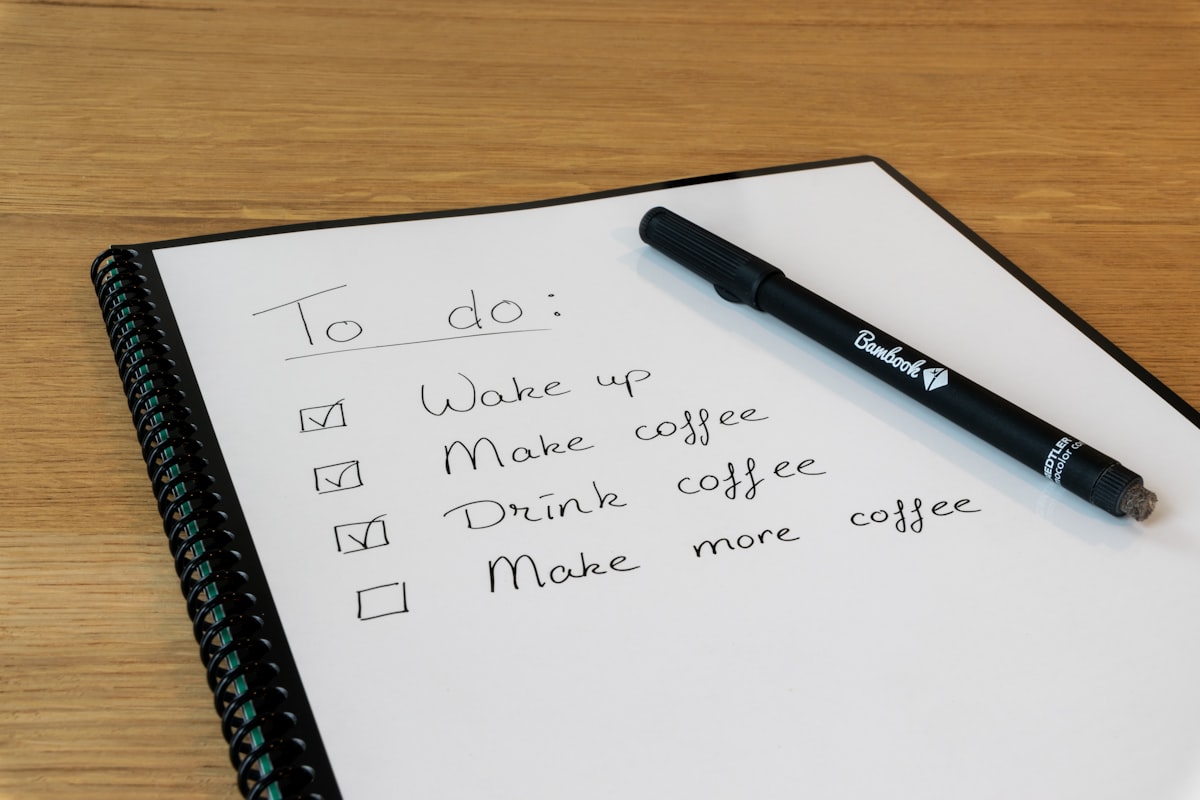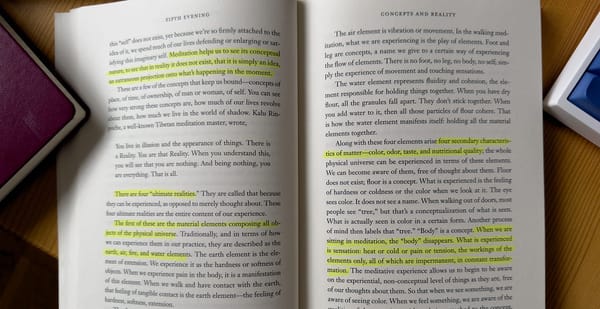Increase Productivity by Mastering the ’To-Do List Mindset’

Ahh, the to-do list. The anchor to every productivity enthusiast’s methodology. I think it goes without saying that if you don’t know what you’re doing, you’re doing it wrong - right?
Well, no.
I understand that a to-do list can be a helpful tool, but I believe that it can also be somewhat oppressive. When we start each day looking at a long list of tasks to complete, we may feel like we’re already behind before we even begin. Instead of getting to zero from -x (x being the number of tasks) every day, what if we changed our mindset and focused on completing tasks with more profound meaning and context? In this blog, I will outline a system for mastering the to-do list mindset that will change your approach to task management and hopefully make you a happier, more productive person in the long run. In addition, this blog will also talk about the types of lists we make and the psychological benefits of the to-do list. I will also recommend some of the applications that I have tried over the years and reveal the one I am using today (and the reasons why)
So, dear readers, buckle up - or add an action to return to this blog later 😆

Why do we make lists
From the ingredients list in a recipe to the instructions on how to assemble an extravagant Meccano set - lists have been with us ever since the cave-woman said to the caveman-
INT. CAVE - MORNING
The CAVEMAN is collecting his things, ready to go hunting.
CAVEWOMAN: I need three fish and some of those herbs that haven't been named yet, and don’t forget to kill that Woolly Mammoth before you come home because he’s been frightening the children.
CAVEMAN: Yes, dear
CAVEWOMAN: You’ll forget you always do - bring me some slate and chalk, and I’ll write it down for you.
Lists are essentially a collection of tasks or items we want to remember. In the modern age, lists are either digital (application-based) or analogue (handwritten). This is a very obvious point to make. However, I will return to this point later in the blog as both have benefits which I think you’ll find interesting.
The psychological benefits of having a to-do list
You’ll agree that nothing is better than a job well done. From cleaning the bathroom to making your bed and planning a holiday (or vacation for my American friends). When we break down larger goals into smaller tasks, we gain some core psychological benefits when we cross something off the list or check a box. This includes:
Cognitive Offloading
David Allen, in the book Getting Things Done, said, “Your mind is for having ideas, not holding them”. And if you’re anything like me, you’ll find that holding onto something simple as remembering to order coffee beans from Amazon before you run out can be quite the struggle. In Chris Bailey’s book, The Productivity Project, the author discusses cognitive limitations. The three main areas (of importance) highlighted are the management of attention, energy and time. So, my opinion is simple - if you write something down in a list, you free up mental fuel to do other things.
Zeigarnik Effect
I am constantly running lists in my head. I can’t help it; it annoys me so much! In my research for this blog, I came across a Lithuanian psychopathologist, Bluma Zeigarnik, who had a theory that incomplete tasks create ‘cognitive tension in our minds’ and, according to the theory - this cognitive tension enhances our memory for the outstanding tasks. I guess this makes sense - how often do you think, “Must do that, must do that.” Interestingly, the Zeigarnik Effect is used as a narrative tool in television drama as a cliffhanger at the end of an episode. The narrative is left with an ‘unfinished task’, which means the viewer probably won’t forget to tune into the following episode to see the conclusion of the cliffhanger. When I first read about this theory, I thought the Zeigarnik Effect was a bad thing. However, in hindsight - it can be leveraged as a positive. For example, you may have a significant goal, and by breaking that up into milestones until the goal is completed, the effect can be leveraged to improve productivity. This cognitive tension ensures that each upcoming task remains, for the want of a better phrase, ‘front of mind’.

Dopamine
I mentioned this before, but it bears repeating. The satisfaction from completing a task, checking off a box in your to-do list, or putting a line through a note in your notepad is genuinely delightful. I believe dopamine’s positive feeling (a biological effect) crosses over into the theory of Endowed Progress, complementing each other.
Endowed Progress is a simple theory stating that the sense of progress in a task provides the motivation to carry on and complete the next task.
Coupling the chemical hit from dopamine with the motivation from the theory of endowed progress may explain how some task management enthusiasts break their days down into smaller, some may argue, menial tasks. I often see the beautifully designed bullet journals or Hobonichi Techos on Pinterest, and they are tracking absolutely everything. From flossing to buying cat food. It does make me wonder if these incredible artists are addicted to the dopamine - or the smell of washy paper. Power to these people, though; the artwork is astonishing and much better than I could ever do. (Anyway, before I go off topic - yet again - let’s continue)
The Types of Lists We Make
The types of lists that we make vary massively and fall into separate categories, such as personal and professional (I would also include hobbies and side projects that are not work-related). At home, my husband and I, both in the Apple ecosystem, use the free Apple application Reminders for a shared shopping list. When either of us sees the milk is nearly out, we add it, and whenever either of us finds ourselves in the supermarket, we can mark items off the list as we buy them - there’s no need to check if we need anything with each other. So we don’t wander around the supermarket waiting for someone to reply to a text message, or even worse, leave and get the reply that we’re out of tea bags on the drive home and have to turn back. The list itself is simple and works perfectly.
I have daily tasks and habits for which I use a different application. These include Morning Pages, Evening Journalling (honestly, I journal a lot - a bit too much, probably), trying to write 1000 words, taking my pills and meditation. The application I use for all other tasks is Actions by Moleskine, which works well with Timepage, my calendar application of choice, also developed by Moleskine as part of their ’Studio’ bundle.
I also keep a list of books I want to read in the same application, along with titles of blogs I have decided that I’m going to write and also steps for the videos I’m editing for YouTube. There’s a task to complete the B-Roll layer and colour-correct the next video. (This will be achieved after I finish writing the blog you are reading.)

The criticality of lists varies as much as the list type, and for this blog, I will focus on lists we make in a professional environment. However, the activities that I’ll be mentioning are easily transferrable.
Digital Applications for Task (& Time Management)
There are many note-taking applications which readers of my blog will be aware of. But there is also an avalanche of to-do list applications. In a recent video from Keep Productive, Francesco gave his top 12 - but also declared that he has reviewed over 250 to-do list applications - TWO HUNDRED AND FIFTY! This shows that there isn’t just a market for your digital list and personal organisation tools; there’s also a growing community of application developers trying to refine, improve and integrate their spin on the humble to-do list application. (And respect to Francesco for sifting through and giving his review on so many of these applications over the years.) In the digital world, the marriage between calendar events and our to-do list is becoming closer than ever. With applications such as Notion Calendar (You’re right, Francesco - the logo is terrible), Morgan and others (including updates coming from Todoist). The application landscape available for us to manage our time and our tasks is wider than ever. However, I think they’re all missing a trick. (Though if there is an application that does what I’m going to suggest, please let me know!)

The appeal of digital to-do lists is quite clear. They are so convenient, and depending on your ecosystem, you can (for the most part) synchronise across devices, and (should you choose) they can harass you with notifications. The other main advantage is the ability to have a bunch of different projects, areas and unsorted lists in a simple and easy-to-manage way. And some applications even use the practice of gamification with goals - when you practice a habit, you’re trying to build. This is a way to give you that dopamine hit graphically. One of the applications that does this better than anyone is Actions by Moleskine - Honestly, it’s beautiful.
Handwritten Lists
If you read my blog ‘How I combated procrastination with the perfect note-taking system’ recently, you would have learned how, in 2024, I have begun to embrace a more analogue way of taking notes and also managing my tasks, particularly at work where I specialise in product operations. I don’t have the greatest handwriting in the world, but I much prefer to write by hand when I can. This is because I have to slow my mind and write very deliberately if I don’t want to struggle to recall what I wrote when I need to return to the note. At work, each note I write needs to be critical information that I will need to remember. From what I wrote in previous blogs, I repeat, it can’t be emotive and must be factual. I would write down the actions from the meeting and keep it simple.
For example:
Azure Public Cloud Managed Service offering Service Definition Review
(1) contact legal to approve SLAs and sign off.
(2) arrange call with Han Solo to peer review the Service Definition overview before next agreed catch up on (date)
Also, I think when you action something on a written list and cross it off in ink, that feeling of dopamine and endowed progress is, in my opinion, amplified significantly.

I now use two notebooks for work, which I carry everywhere. I try not to bring my MacBook Pro into meetings if I don’t need it because it’s distracting. I also find it rather rude when someone is in a meeting, and they’re typing an email or hasn’t muted their device, and someone starts randomly calling them on Microsoft Teams. The reason I have two is that one is simply for notes that I take in a meeting. This is, for my stationary enthusiast friends (yes, stationary enthusiasts exist, and we’re all fantastic), the Leuchtturm 1917 A5 (lined, hardback), and the second is a Hobonichi Techo Cousin (A6 - one day per page annual ‘life book’). The second is purely for to-do lists. (And only for my day job to-do lists) - I also use the Hobonichi Cousin HON for my evening journal as this restricts me to a single page daily, so I need to be disciplined and not write reams and reams. (Anyway, I digress…)
Own the list, don’t let the list own you
The traditional way of making a to-do list is best practice. It’s hard to argue that. Before I finish work, I look through my notes from the day, knowing that any actions will get lost if I leave them. I will write my action tomorrow in my A6 dedicated to-do notebook. This is the blueprint for the next day. I will check my calendar for meetings and, if necessary, time block (if I can) should I need to, allowing me the capacity to complete the tasks on the list. I also subscribe to the David Allen Getting Things Done (GTD) methodology - if it takes less than 2 minutes, do it immediately.
It’s so easy to begin to work the next day, and you find yourself staring at a monster list that seems to get larger as the day progresses. The feeling of constantly being in debt to the list as you begin your day at -x and just as we perpetuate the ambition of inbox-zero, the aspiration of to-do list-zero is far, far away. When we as professionals lose control of the list and feel owned by it, the list’s items begin to merge, and prioritisation goes out the window. You may find that you get to a task, and you can’t remember the context the action belonged to, or you are stuck in a chain of information because the thing you were waiting for from Luke Skywalker in accounts hasn’t been completed because he’s in a similar to-do list catastrophe as you are.
To truly take charge of our time and tasks, we must develop a To-Do List Mindset. Poor time management and task prioritisation go beyond mere systems and require a proactive approach to conquer.

What is the To-Do List Mindset?
The What
The to-do list mindset is more than the concepts of both productive control and structured thinking. But it also is the complete understanding to be confident that everything on the list has meaning and context. When we think about why we procrastinate, the underlying reason is a lack of confidence or knowledge needed to complete the task. The to-do list mindset method is designed to ensure that you have the confidence and expertise to complete the task and the control to ensure the task is completed by the date you said it would be.
The Why
I think that in professional situations where we have to juggle multiple projects with varying complexities, it’s essential that we spend less time fussing about trying to get control of our lists. This isn’t because I think we get ‘more things done’; I believe if we are in a position of people management, for example, our skills as people managers can suffer due to not having this mindset. We can fall into the trap of being so focused on operations that we forget about the welfare of our teams. If you’re not in senior leadership or a people manager, this method can also help you. If you ever find yourself in a situation where you’re with your family but not entirely present with them because you’re worried about the list at work. I think you may miss out on some valuable time, and something you may regret later in life. The ripple effect of having a grip on your list can be significant.
Psychological Benefits
I have already mentioned some of the psychological and biological benefits of a to-do list, and this is designed to ensure that it capitalises on those positives. In my daily professional life, I must be able to recall a lot of information on the status of each project. This is partly why I keep a handwritten list, as it’s far easier to retain critical facts when I’ve written them by hand. In addition, the concept behind the method is designed so that you don’t start your day in to-do list debt.
The Method
Two Lists - A Cycle of Outcomes and Actions
The idea of a ‘done list’ isn’t a new one. I’ve read about them in a few books on productivity over the years, so this method takes the two simple concepts and brings them together.
The two lists - a done list and a to-do list are designed to work together as a pair. In most professional scenarios, any action you need to complete will be associated with an outcome. The outcome of the previous action(s) provides the context in a cycle that continues until the project is completed. It looks something like this:

If we were to put this into practice, the outcome and actions might look something like this - with the outcome being the ‘Done’ and the action being the ‘To Do’ -
Azure Public Cloud Managed Service offering Service Definition Review
Outcomes
(1) SLAs agreed on points on pages 3-5,
(2) The overview page draft was completed.
Actions
(1) contact legal to approve SLAs and sign off. (set up meeting)
(2) arrange a call with Han Solo to peer review the Service Definition overview before the next agreed catch up
Outcomes
(1) Legal have reviewed SLAs and have a few concerns in 2 areas
(2) Call completed and the overview page has been signed off. (Completed)
Actions
(1) Speak to the service delivery manager/ set up a meeting with legal to discuss concerns
Where the method is designed to strengthen the users’ mindset when it comes to task management, and their list is that it is designed so that you’re not mentally thinking, “I need to do x, y and z”, but rather, to shift to the positive ‘x and y have been completed today - tomorrow I’ll need to do z.’
Strength in Simplicity
In my previous career as the Head of Bid Management - a specialism I worked in for over 15 years- I mentored and guided many people from the world of bid management, sales, and marketing. One of the main pieces of advice I give bid writers when starting their careers is, ‘Don’t try and be clever. ‘ If you aren’t keeping it simple, it is possible to miss the point of the question being asked, or the response is structured in a way that may not make total sense to the reader.
I have a fundamental belief in the strength of simplicity.
So, let’s make it simple.
Each meeting, you should be writing concise and considered notes that are either an outcome or an action from what is being discussed (or a core piece of information you may need to recall later)
At the end of the day, after several meetings, you’ll need to set aside a bit of reflection time to go through the last few pages of notes and make two lists that are side-by-side - therefore, for the example that I have been using - it may look something like this.

There are a couple of things that you can also do to help take even more control of the next day when you compile your lists. There is no right or wrong way to approach this; it’s personal to your specific workflow.
Prioritisation
The rock and sand analogy regarding productivity has been knocking around for years. This is the concept that if you were to lay out all your projects, tasks, epics and features into a row, they go from large to small (rocks, pebbles to sand) - the day is the metaphorical jar in which you will be to place the rocks and the sand into. If you place the rocks first and then pour in the sand, this will take up all the spare room, and, in theory, you can get it all done. In the book ‘Four Thousand Weeks: Time Management for Mortals’ by Oliver Burkeman, Burkeman says that this concept was first ‘inflicted’ (good word use, Burkeman) on the world in the book First Things First by Stephen Covey (1994) with the summary being,
The moral is that if you make time for the most important things first, you’ll get them all done and have plenty of room for less important things besides. But if you don’t approach your to-do list in this order, you’ll never fit the bigger things in at all.
Burkeman, Oliver. Four Thousand Weeks: Embrace your limits. Change your life. Make your four thousand weeks count. (pp. 72-73). Random House. Kindle Edition.
Burkeman continues, this is a point that I wholeheartedly agree with, and this is why I believe that prioritisation when assembling your lists is personal to you:
The real problem of time management today, though, isn’t that we’re bad at prioritising the big rocks. It’s that there are too many rocks – and most of them are never making it anywhere near that jar. The critical question isn’t how to differentiate between activities that matter and those that don’t, but what to do when far too many things feel at least somewhat important, and therefore arguably qualify as big rocks.
Burkeman, Oliver. Four Thousand Weeks: Embrace your limits. Change your life. Make your four thousand weeks count. (p. 73). Random House. Kindle Edition.
So, if you have some low-hanging fruit (low-effort tasks) that you can get out of the way quickly, go for it. There is no rule as to the ordering of the list. You could add a third column, should you wish, with a task completion due date. Any tasks that are not completed are moved into the next daily lists.
Confidence in Key
Imposter syndrome is a genuine thing in today’s working world. I have seen it, and I also suffer from it. One of the ways that I try to combat imposter syndrome is to build confidence in what I am doing each day. And this involves taking control of my to-do list mindset. Many languages read from left to right on the page, so when we look at the done and to-do list in the morning, we first read something done; we’re cooking on gas! Immediately, we’re off on a positive footing because we aren’t in debt to a list; we’re progressing with something that was completed very simply. This will, in turn, help those who adopt this method build confidence and focus.
Every task we manage and add to our to-do list is part of a journey. The cycle of action and outcome, action and outcome, is the foundation of that journey. Building a done list and making it integral to the system you utilise to manage your workload and task management will pay dividends.
Thank you so much for reading.
If you haven’t signed up already, I blog about everything from productivity and procrastination to technology, health, wellness - all sorts of things. You will find some subjects more interesting than others, but it’s not eniterly boring.
Sign up for my free monthly newsletter at www.notentirelyboring.com



